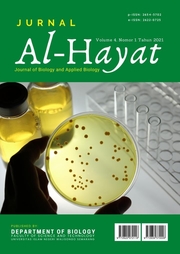Microbiological Analysis of Liquid Lipstick Products Used by Makeup Artists
Main Article Content
Abstract
Abstract
Lipstick is a non-sterile pharmaceutical product that is used for make-up on the lips. Liquid lipstick used by makeup artists may have a high level of microbial contamination because they are applied to different clients in turn. This study aims to determine the microbiological quality of liquid lipstick used by makeup artists based on the result of the Bacterial Total Plate Count (TPC), Yeast and Mold Count (YMC), and the presence of pathogenic microbes. Three samples of liquid lipstick were taken from three different makeup artists and one sample was a new liquid lipstick product. The Bacterial TPC test was carried out on TSA media and the YMC test was carried out on SDA with the spread plate technique. The presence of microbial pathogens P. aeruginosa, S. aureus, and C. albicans were carried out on selective media. The results of bacterial TPC was 9.0 × 103 to 3.0 × 104 CFU/mL, while the YMC was 1.1 × 103 to 3.1 × 103 CFU/mL. The pathogenic microbes detected were S. aureus in 2 samples and C. albicans in 1 sample. The bacterial TPC and YMC values exceed the contamination limit based on BPOM Regulation No. 12/2019.
Downloads
Article Details
The copyright of the received article shall be assigned to the journal as the publisher of the journal. The intended copyright includes the right to publish the article in various forms (including reprints). The journal maintains the publishing rights to the published articles. Authors are allowed to use their articles for any legal purposes deemed necessary without written permission from the journal with an acknowledgment of initial publication to this journal.
The work under license Creative Commons Attribution-ShareAlike 4.0 International License.
References
Armijo, Leisha M., Stephen J. Wawrzyniec, Michael Kopciuch, Yekaterina I. Brandt, Antonio C. Rivera, Nathan J. Withers, Nathaniel C. Cook, et al. 2020. Antibacterial Activity of Iron Oxide, Iron Nitride, and Tobramycin Conjugated Nanoparticles against Pseudomonas Aeruginosa Biofilms. Journal of Nanobiotechnology 18 (1): 1–27.
Belitz, H.D., W. Grosch, and P. Schieberle. 2009. Springer Food Chemistry 4th Revised and Extended Edition. Annual Review Biochemistry. Berlin: Springer.
BPOM. 2011. Peraturan Kepala Badan Pengawas Obat Dan Makanan Republik Indonesia No. HK.03.1.23.08.11.07331 Tentang Metode Analisis Kosmetika. Jakarta: BPOM RI.
Dicastillo, C. L., M. G. Correa, F. B. Martinez, C. Streitt, and M. J. Galotto. 2020. Antimicrobial Effect of Titanium Dioxide Nanoparticles. London: IntechOpen.
Halla, Noureddine, Isabel P. Fernandes, Sandrina A. Heleno, Patrícia Costa, Zahia Boucherit-Otmani, Kebir Boucherit, Alírio Egídio Rodrigues, Isabel C.F.R. Ferreira, and Maria Filomena Barreiro. 2018. Cosmetics Preservation: A Review on Present Strategies. Molecules 23 (7): 1–41.
Hutajulu, B. R. 2020. Sintesis Surfaktan Berbasis Asam Amino N-Lauroyl Lysine Dari Asam Laurat Dengan Menggunakan Katalis Kalsium Oksida. Medan: Universitas Sumatera Utara.
Jiang, Xuhong, Bin Lv, Yuan Wang, Qianhong Shen, and Xinmin Wang. 2017. Bactericidal Mechanisms and Effector Targets of TiO2 and Ag-TiO2 against Staphylococcus Aureus. Journal of Medical Microbiology 66 (4): 440–46.
Mayer, François L, Duncan Wilson, and Bernhard Hube. 2013. Candida Albicans Pathogenicity. Virulence 4 (2): 119–28.
Muthi’ah, W., R. Octavianty, and M. S. N. Wahyuni. 2017. Tinjauan Desain Beauty Case Di Kalangan Makeup Artist Jakarta. NARADA – J. Desain & Seni UMB, 335–44.
Noor, A. I., W. M. Rabih, A. A. Alsaedi, M. S. Al-Otaibi, M. S. Alzein, Z. M. Alqireawi, K. A. Mobarki, R. A. AlSharif, and H. S. Alfaran. 2020. Isolation and Identification of Microorganisms in Selected Cosmetic Products Tester. African Journal of Microbiology Research 14 (9): 536–40.
Okayo, Robert O., Darius O. Andika, Mathews M. Dida, George O. K’otuto, and Bernard M. Gichimu. 2020. Morphological and Molecular Characterization of Toxigenic Aspergillus Flavus from Groundnut Kernels in Kenya. International Journal of Microbiology 2020.
Priestley, R. D., and R. K. Prud’homme. 2020. Polymer Colloids: Formation, Characterization, and Applications. Croydon: Royal Society of Chemistry.
Rahayu, K. D. A., I. N. Jirna, and Burhanuddin. 2019. UJI ANGKA KAPANG KHAMIR DAN IDENTIFIKASI Aspergillus Species PADA JAMU KUNYIT DI DENPASAR SELATAN. Meditory : The Journal of Medical Laboratory 7 (1): 17–26.
Rasooly, Reuven. 2005. Expanding the Bactericidal Action of the Food Color Additive Phloxine B to Gram-Negative Bacteria. FEMS Immunology and Medical Microbiology 45 (2): 239–44.
Sawant, Sneha Sunil, and Varsha Kelkar-Mane. 2015. Study of Bacterial Contaminants in Local as Well as Branded Lipsticks before and after Consumer Use. International Journal of Recent Advances in Multidisciplinary Research 2 (1): 149–54.
Sharma, Gaurav Kumar, Jayesh Gadiya, and Meenakshi Dhanawar. 2018. A Textbook of Cosmetic Formulations. India: Kbuuk publications, Houston and Pothi.com.
Sundari, Sri, and Fadhliani. 2019. Uji Angka Lempeng Total ( ALT ) Pada Sediaan Kosmetik Lotion X Di BBPOM Medan. Jurnal Biologica Samudra 1 (1): 25–28.
Švedienė, Jurgita, Vitalij Novickij, Rokas Žalnėravičius, Vita Raudonienė, Svetlana Markovskaja, Jurij Novickij, and Algimantas Paškevičius. 2021. Antimicrobial Activity of L-Lysine and Poly-l-Lysine with Pulsed Electric Fields. Applied Sciences (Switzerland) 11 (6).
Takakura, Yasuaki, and Yasuhisa Asano. 2019. Purification, Characterization, and Gene Cloning of a Novel Aminoacylase from Burkholderia Sp. Strain LP5_18B That Efficiently Catalyzes the Synthesis of N-Lauroyl-L-Amino Acids. Bioscience, Biotechnology and Biochemistry 83 (10): 1964–73.
Taylor, T. A., and C. G. Unakal. 2021. Staphylococcus Aureus. StatPearls. 2021. https://www.ncbi.nlm.nih.gov/books/NBK441868/.
Vassoler, Mireli, Fabiana Tonial, Silvia Cristina Fagundes, Micheila Alana Fagundes, Nágila Bernarda Zortéa, Luciana Grazziotin Rossato-Grando, and Charise Dallazem Bertol. 2020. Microbiological Contamination of In-Store Lipstick Testers Available to the Consumer. Mundo Da Saude 55 (3): 261–68.
Vidal, Laetitia, Véronique Thuault, Arturo Mangas, Rafael Coveñas, Anne Thienpont, and Michel Geffard. 2014. Lauryl-Poly-L-Lysine: A New Antimicrobial Agent? Journal of Amino Acids 2014: 1–10.
Wendy. 2016. Gambaran Kontaminasi Bakteri Dan Jamur Pada Sampel Lipstik Mahasiswi Fakultas Kedokteran Universitas Sumatera Utara. Medan: Universitas Sumatera Utara.

